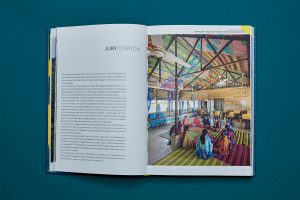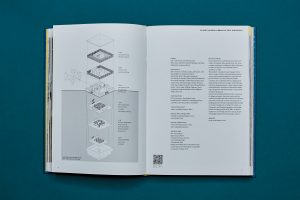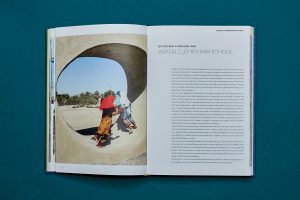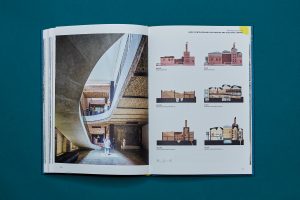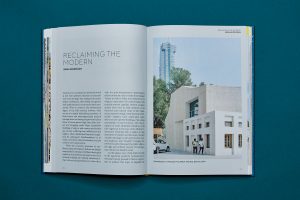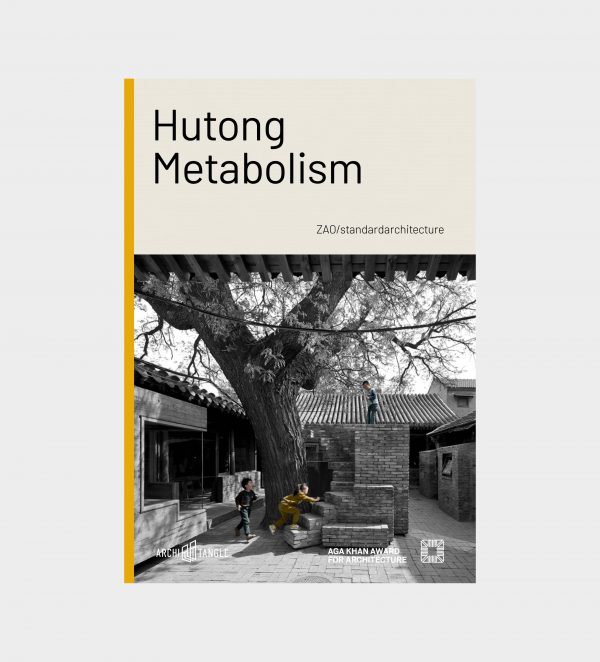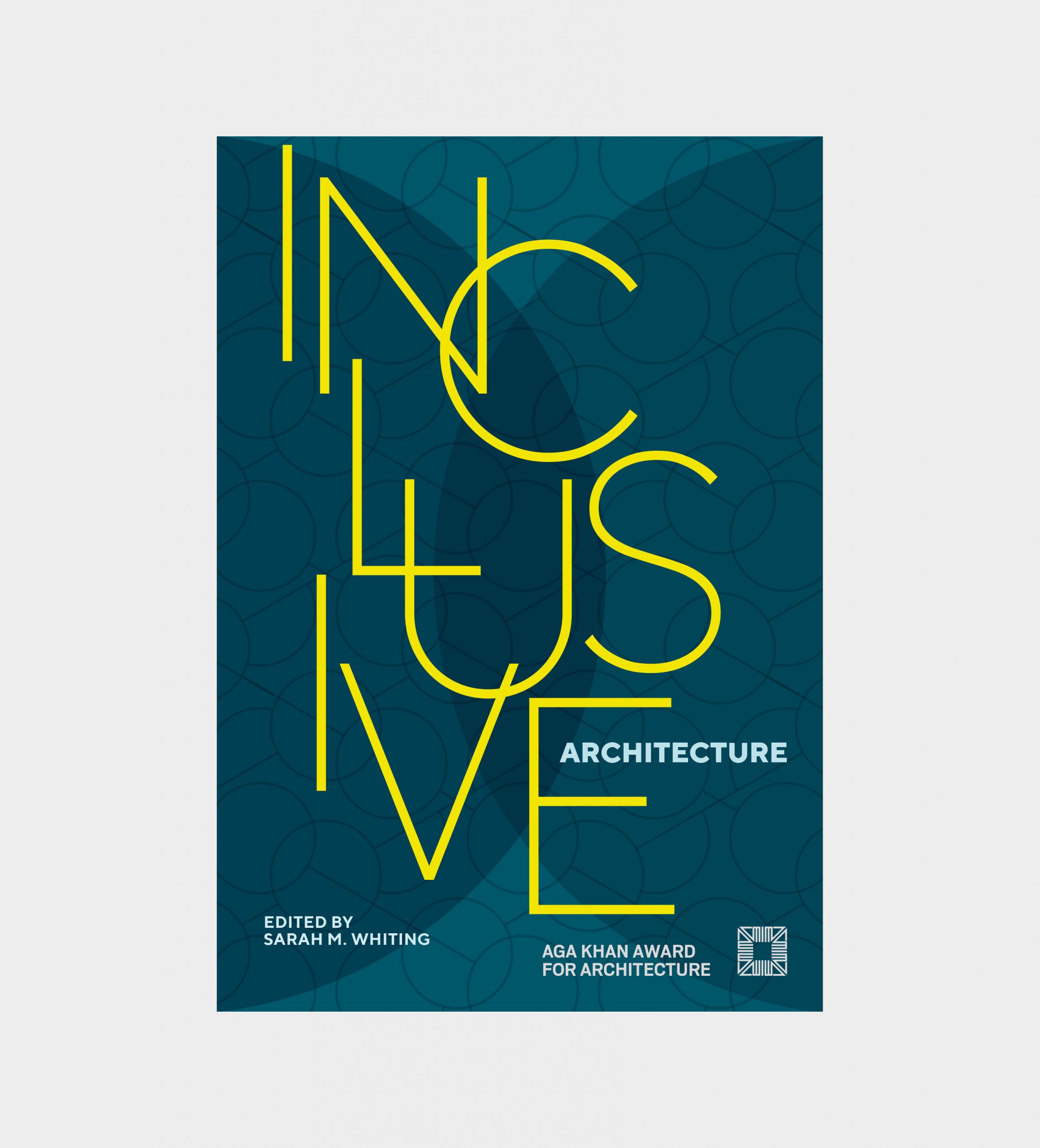
Inclusive Architecture
Aga Khan Award for Architecture 2022
38,00 €
Edited by Sarah M. Whiting
Description
The release of the Aga Khan Award for Architecture every three years is an enormously important moment for the architecture world. The projects recognized by this Award represent the vanguard of thinking and practice in architecture that goes beyond the regular scope of building, planning and preservation through its strong impact on the needs and aspirations of societies. This publication presents the twenty shortlisted projects, including the six recipients of the 2020–22 cycle of the Award.
The Aga Khan Award for Architecture’s mandate is different from that of many other architecture prizes: it not only rewards architects but also identifies municipalities, builders, clients, artisans and engineers who have played essential roles in the realization of a project. This publication thus presents the projects from various viewpoints alongside detailed and up-to-date images and descriptions.
The acclaimed, interdisciplinary master jury and steering committee of this cycle of the Aga Khan Award for Architecture that determines the projects presented include David Chipperfield, Francis Kéré, Anna Lacaton, Marina Tabassum, and Sarah M. Whiting, to name but a few. Scholarly essays across various disciplines from members of the master jury and steering committee round out the publication. Contributions include a text on the optimism of humanity by Souleymane Bachir Diagne, director of the Institute of African Studies, Columbia University, and a contextualization of Modern Architecture in the Muslim World by Sibel Bozdoğan of Boston University. Kazi Khaleed Ashraf, director-general of the Bengal Institute for Architecture, Landscapes and Settlements, in Dhaka, Bangladesh, writes on the perspective of the dialogical, while Nasser Rabbat, the Aga Khan Professor at MIT, shares notes on architecture as a humanist empire. The texts also include a Salon des Refusés by Nader Teherani, founding principal of Boston-based architecture firm NADAAA.
The texts, which come from a wide range of geographies, are informative and descriptive, often striking an emotional note. Together with the project presentations, the publication thereby guides the reader through a contemplation of an architectural question of increasing urgency in our current times of crisis: how to build ethically for our shared global future.
With contributions by Kazi Khaleed Ashraf, Sibel Bozdoğan, Souleymane Bachir Diagne, Farrokh Derakhshani, Nasser Rabbat, Nader Teherani, and Sarah M. Whiting.
Details
| Weight | 950 g |
|---|---|
| Dimensions | 245 × 170 × 30 mm |
| Edited by | Sarah M. Whiting |
| Texts by | Farrokh Derakhshani, Sarah M. Whiting, Souleymane Bachir Diagne, Sibel Bozdogan, Nader Tehrani, Kazi Khaleed Ashraf and Nasser Rabat |
| Language | English |
| Art Director | Julia Wagner, grafikanstalt |
| Features | Hardback, full color, stich bound, finishing with UV-varnish and embossing |
| Size | 17 x 24,5 cm, 6.7 x 9.6 in |
| Illustrations | approx. 210 |
| Page count | 328 pages |
| Date | October 2022 |
| ISBN | 978-3-96680-022-8 |
Projects
All 20 shortlisted projects are covered in the book.
Bahrain
Rehabilitation of Manama Post Office, Manama, Bahrain, by Studio Anne Holtrop: Built in 1937, the Post Office was rehabilitated to its original form and role as a functioning post office, and added a new wing to the existing building.
Bangladesh
Community Spaces in Rohingya Refugee Response, Teknaf, Bangladesh, by Rizvi Hassan, Khwaja Fatmi, Saad Ben Mostafa: Sustainably built structures in the world’s largest refugee camps, which occurred collaboratively in the field without drawings or models.
Urban River Spaces, Jhenaidah, Bangladesh, by Co.Creation.Architects / Khondaker Hasibul Kabir, Suhailey Farzana: A community-driven project providing public spaces in a riverine city with 250,000 residents, offering walkways, gardens and cultural facilities, as well as environmental efforts to increase biodiversity along the river.
Cape Verde
Outros Bairros Rehabilitation Programme, Mindelo, Cape Verde, by OUTROS BAIRROS / Nuno Flores: An urban rehabilitation and redesign of a public space allowed residents to execute works in their own neighbourhoods and enhance their sense of belonging.
India
Lilavati Lalbhai Library at CEPT University, in Ahmedabad, India, by RMA architects / Rahul Mehrotra: The library, a living case study of passive climate mitigation strategies, integrates seamlessly into the existing campus while forging its own distinct identity.
Indonesia
Blimbingsari Airport, Banyuwangi, Indonesia, by andramatin: Serving more than 1,100 domestic passengers per day, the airport’s roofs indicate a clear division between departure and arrival halls.
Expandable House, Batam, Indonesia, by ETH Zurich / Stephen Cairns with Miya Irawati, Azwan Aziz, Dioguna Putra and Sumiadi Rahman: This new sustainable dwelling prototype is designed to be flexibly configured around its residents’ (often) precarious resources over time.
Iran
Aban House, Isfahan, Iran, by USE Studio / Mohammad Arab, Mina Moeineddini: On a narrow rectangular site in Isfahan’s historic centre, the three-storey house is arranged around three open courtyards.
Argo Contemporary Art Museum & Cultural Centre, Tehran, Iran, by ASA North / Ahmadreza Schricker: Distinct materials differentiate new additions from the brick-built historic fabric in this contemporary art museum housed in an abandoned 100-year-old brewery.
Jadgal Elementary School, Seyyed Bar, Iran, by DAAZ Office / Arash Aliabadi: An elementary school, managed by villagers and teachers and funded by tourism and needlework from local women, is a sustainable development centre for surrounding areas.
Lebanon
Renovation of Niemeyer Guest House, Tripoli, Lebanon, by East Architecture Studio: Designed by Oscar Niemeyer but abandoned when civil war erupted in 1975, the guest house has been transformed into a design platform and production facility for the local wood industry.
Kuwait
Wafra Wind Tower, Kuwait City, Kuwait, by AGi Architects: The 13-storey building conceived as a wind tower features a central, vertical courtyard that provides natural ventilation to each apartment unit.
Morocco
Issy Valley Improvement, Ait Mansour, Morocco, by Salima Naji: While improving the palm orchards and water reservoirs, trails and facilities for tourists were also upgraded in the first phase of a larger project for the valley.
Niger
Niamey 2000, Niamey, Niger, by united4design / Yasaman Esmaili, Elizabeth Golden, Mariam Kamara, Philip Straeter: As a response to a housing shortage amid rapid urban expansion, this prototype housing of six family units seeks to increase density while remaining culturally appropriate.
Palestine
Tulkarm Courthouse, Tulkarm, Palestine, by AAU Anastas: Featuring two buildings, one for administration and the other containing 10 courtrooms, the Courthouse is anchored to its urban context by a public space.
Senegal
CEM Kamanar Secondary School, Thionck Essyl, Senegal, by Dawoffice / David Garcia, Aina Tugores: For this secondary school, volunteers, using local techniques, produced vault modules from clay which (with lattices) act as evaporating coolers.
Sri Lanka
Lanka Learning Centre, Parangiyamadu, Sri Lanka, by feat.collective / Noemi Thiele, Felix Lupatsch, Valentin Ott and Felix Yaparsidi: A multifunctional cultural centre and adult school where locals learn craftsmanship creates a multi-ethnic meeting point.
Tunisia
Le Jardin d’Afrique, Zarzis, Tunisia, by Rachid Koraïchi: An ecumenical cemetery provides a sanctuary and dignified place of final repose for the hundreds of unburied bodies that had been washing ashore.
Turkey
Rehabilitation of Tarsus Old Ginnery, Tarsus, Turkey, by Sayka Construction Architecture Engineering Consultancy: Adaptive reuse of an abandoned 19th century ginnery allows the operation of a contemporary centre for archaeological research and public engagement.
United Arab Emirates
Flying Saucer Rehabilitation, Sharjah, United Arab Emirates, by SpaceContinuum Design Studio / Mona El Mousfy: The Flying Saucer, a 1978 Brutalist-style building that was fully restored as a community art space, contributes to Sharjah’s collective cultural memory.
Contributors' Biographies
Sarah M. Whiting has been the Dean and Josep Lluís Sert Professor of Architecture at the Harvard University Graduate School of Design since 2019. She served as the Dean of Rice University’s School of Architecture from 2010 to 2019. She is also a design principal and co-founder of WW Architecture. Professor Whiting received a Bachelor of Arts degree in architecture, urban history, and theory from Yale University, a Master of Architecture from Princeton University in 1990, and a Doctor of Philosophy in the History and Theory of Architecture from the Massachusetts Institute of Technology in 2001. Professor Whiting worked with the Office for Metropolitan Architecture in Rotterdam, The Netherlands, and with Peter Eisenman in New York. She has taught design, history, theory, and criticism at additional institutions, including Princeton University, the Illinois Institute of Technology, the University of Kentucky, and the University of Florida. She frequently lectures throughout the US and abroad, and regularly serves as a critic of architecture and urban design.
Professor Whiting’s research is broadly interdisciplinary, with the built environment at its core. An expert in architectural theory and urbanism, she has particular interests in modern and contemporary architecture’s relationship with politics, economics, and society, and how the built environment shapes the nature of public life. Her work has been published in leading journals and collections. She is also the founding editor of Point, a book series aimed at shaping contemporary discussions in architecture and urbanism.
Professor Whiting’s writings have been published in journals ranging from ANY to Wired, as well as in collections including Shaping the City, Mies in America, Six Authors in Search of an Architect, and An Architecture for all Senses: The Work of Eileen Gray. She edited Differences, a collection of essays by Ignasi de Solà-Morales, and served as reviews editor for the journal Assemblage from 1996 to 2001. She currently serves on the editorial boards of the journals LOG, The Plan, and Thresholds.
Kazi Khaleed Ashraf is the director-general of Bengal Institute for Architecture, Landscapes and Settlements, in Dhaka, Bangladesh. The Bengal Institute focuses on challenges of the contemporary city, and the organization of land, water and settlements, in the critical ecological dynamics of a terraqueous landscape. As an architect, urbanist and architectural historian, Ashraf works at the intersection of settlement-form, landscape architecture, and architectural theory. He is involved in townscape and urban design for several cities and towns in Bangladesh, and currently directing a multi-disciplinary research project on the River Padma, the last leg of the Ganges, that involves historical, settlement and ecological investigations of the largest delta in the world.
After teaching at the University of Hawaii at Manoa, University of Pennsylvania, Temple University and Pratt Institute in the US, Ashraf became instrumental in establishing the Bengal Institute as a major centre of urban investigation and architectural activism. Ashraf received a PhD from the University of Pennsylvania and his Masters from MIT and BArch from BUET in Dhaka.
Ashraf has authored several books and numerous essays on various historical and theoretical topics, including architecture in India and Bangladesh, and the city of Dhaka. His writings on the architecture of Bangladesh have provided a theoretical ground for understanding both the historical and contemporary forms of architecture in the region. Ashraf’s publications include: The Hermit’s Hut: Architecture and Asceticism in India; Designing Dhaka: A Manifesto for a Better City; An Architect in Bangladesh: Conversations with Muzharul Islam; and Louis Kahn’s National Capital in Bangladesh. His articles and essays have appeared in numerous publications, including The Architectural Review, Architectural Design, Journal of Architectural Education, RES, MIMAR and Economic and Political Weekly. Ashraf has established an international publication series called Locations: Anthology of Architecture and Urbanism that presents works and features from around the globe.
Nasser Rabbat is the Aga Khan Professor and Director of the Aga Khan Program for Islamic Architecture at MIT. His interests include Islamic architecture, urban history, heritage studies, Arab history, contemporary Islamic art, and post-colonial criticism. He has published numerous articles and several books on topics ranging from Mamluk architecture to Antique Syria, 19th century Cairo, Orientalism, and urbicide. His most recent books are ‘Imarat al-Mudun al-Mayyita (The Architecture of the Dead Cities) (2018), and an online book, The Destruction of Cultural Heritage: From Napoléon to ISIS, co-edited with Pamela Karimi (2016). His book on the 15th century Egyptian historian al-Maqrizi will come out in early 2022. He is currently editing a book on the cultural history of Syria (EUP, 2023), and co-editing another on heritage conservation, destruction, and reconstruction (AUC Press, 2022).
He has previously published: al-Naqd Iltizaman (Criticism as Commitment), Mamluk History Through Architecture: Building, Culture, and Politics in Mamluk Egypt and Syria, Thaqafat al Bina’ wa Bina’ al-Thaqafa (The Culture of Building and Building Culture), and The Citadel of Cairo: A New Interpretation of Royal Mamluk Architecture. He edited The Courtyard House between Cultural Reference and Universal Relevance, co-edited Making Cairo Medieval, and co-authored Interpreting the Self: Autobiography in the Arabic Literary Tradition.
Professor Rabbat worked as an architect in Los Angeles and Damascus and held several academic and research appointments in Cambridge (Massachusetts, USA), Princeton, Los Angeles, Cairo, Granada, Rome, Paris, Abu Dhabi, Doha, Munich, and Bonn. He regularly contributes to several Arabic newspapers, serves on the boards of various cultural and educational organisations, and consults with international design firms on projects in the Islamic World. In recent years, he began researching and publishing on immigration, refugees, heritage conservation, and destruction and reconstruction. Nasser Rabbat served as a member of the 2019 Aga Khan Award for Architecture Steering Committee.
Sibel Bozdoğan is Visiting Professor of Modern Architecture and Urbanism, Department of the History of Art and Architecture at Boston University. Professor Bozdoğan is interested in critical theories of modernity, identity, nationalism, regionalism and postcolonialism and has been an advocate for global perspectives in the writing/teaching of critical, cross-cultural histories of modern architecture.She has published numerous articles on these topics and teaches courses ranging from “National Landscapes” and “Vernacular Modernisms” to surveys of 20th century architecture from the Americas to the Mediterranean and the Middle East.
She is the author of Modernism and Nation Building: Turkish Architectural Culture in the Early Republic (University of Washington Press, 2001), which won the Alice Davis Hitchcock Award of the Society of Architectural Historians and the Köprülü Book Prize of the Turkish Studies Association. Her publications include a monograph on the Turkish architect Sedad Eldem, an interdisciplinary volume, Rethinking Modernity and National Identity in Turkey (co-edited with Reşat Kasaba) and Turkey: Modern Architectures in History (co-authored with Esra Akcan). She is currently leading and co-editing (with Panayiota Pyla and Petros Phokaides), an international collaborative book project Coastal Architectures and Politics of Tourism: Leisurescapes in the Global Sunbelt.
She holds a professional degree in architecture from the Middle East Technical University, Ankara and a Ph.D. from the University of Pennsylvania. She has taught architectural history and theory courses at Rensselaer Polytechnic Institute, MIT and Harvard GSD, and has served as the Director of Liberal Studies at the Boston Architectural Center. Dividing her time between Boston and Turkey, she has also taught at Bilgi and Kadir Has Universities in Istanbul and was the Chair of the latter’s Architecture Department between 2014 and 2017. She is the recipient of the 2018 Turkish Chamber of Architects National Award for “Lifetime Contribution to Architecture in Turkey”.
Nader Tehrani is Founding Principal of NADAAA, a practice dedicated to the advancement of design innovation, interdisciplinary collaboration, and an intensive dialogue with the construction industry. For the past seven years in a row, NADAAA has ranked in the top eleven design firms in Architect magazine’s “Top 50 Firms in the United States”, ranking “first” for three years in a row. Mr. Tehrani is also Dean of The Irwin S. Chanin School of Architecture at The Cooper Union.
For his contributions to architecture as an art, Nader Tehrani is the recipient of the 2020 Arnold W. Brunner Memorial Prize from The American Academy of Arts and Letters, to which he was also elected as a Member in 2021, the highest form of recognition of artistic merit in The United States. Throughout his career, Tehrani has received eighteen Progressive Architecture Awards and numerous national and international design awards.
His work has also been recognized with a number of awards, including the Cooper Hewitt National Design Award in Architecture, and the United States Artists Fellowship in Architecture and Design. He has also received two Harleston Parker Medals and several BSA Honor Awards. He is also the recipient of the 2021 Hotchkiss Alumni Award.
He served as the Frank O. Gehry International Visiting Chair in Architectural Design at the University of Toronto and the inaugural Paul Helmle Fellow at California State Polytechnic University, Pomona. He has also recently served as the William A. Bernoudy Architect in Residence at the American Academy in Rome.
Nader Tehrani received a B.Arch from The Rhode Island School of Design in 1986. He continued his studies at The Architectural Association, where he attended the Post-Graduate program in History and Theory. Upon his return to The United States, Tehrani received his M.A.U.D from The Harvard Graduate School of Design in 1991.
Souleymane Bachir Diagne is a professor of Philosophy and Francophone Studies at Columbia University and the Director of the Institute of African Studies. An alumnus of the Ecole Normale Supérieure, Professor Diagne holds a PhD in Philosophy from Sorbonne University. Prior to his appointment at Columbia, Professor Diagne taught philosophy at Cheikh Anta Diop University in Dakar, Senegal, for twenty years before joining Northwestern University in 2002 as a professor in the departments of Philosophy and Religion, with an affiliation to the Program of African Studies.
His fields of research and teaching include history of philosophy, history of logic and mathematics, Islamic philosophy, African Literature and Philosophy. His publications include: Boole, l’oiseau de nuit en plein jour (1989), a study of George Boole’s algebra of logic; Islam and the Open Society: Fidelity and Movement in Muhammad Iqbal’s Thought (2001); Léopold Sédar Senghor, l’art africain comme philosophie (2007). He is the author of African Art as Philosophy: Senghor, Bergson, and the Idea of Negritude (Seagull Books, 2011), The Ink of the Scholars: Reflections on Philosophy in Africa (Dakar, Codesria, 2016), Open to Reason: Muslim Philosophers in Conversation with Western Tradition (New York, Columbia University Press, 2018). In Search of Africa(s). Universalism and Decolonial Thought (co-author of the dialogue: Jean-Loup Amselle), Cambridge, UK & Medford, MA, Polity Press, 2020. Professor Diagne is co-director of Ethiopiques, a Senegalese journal of literature and philosophy, and is on the editorial board of Présence Africaine (Paris), among several other scientific institutions.
Among Professor Diagne’s honours are Chevalier dans l’Ordre national du Lion, from the Government of Senegal, as well as Grand Croix dans l’Ordre national du Mérite and Officier de l’Ordre National des Arts et Lettres from the French government. An associate member of the Royal Academy of Belgium and a member of the American Academy of Arts and Sciences, Professor Diagne also served on the Aga Khan Award for Architecture Master Jury in 2010.
Look Inside
book+
Shipping
Quick and affordable delivery cost for this product:
| Germany: | Free |
| Europe (EU): | only EUR 4,90 per order (or free on any order of 2+ books) |
| Europe (Non-EU): | only EUR 9,90 per order |
| World: | only EUR 9,90 for this item |
Same day shipping for any order placed by 13:00 CET (German time, workdays). Premium tracked shipping worldwide provided by ![]()
Related Products
-
Hutong Metabolism
ZAO/standardarchitecture38,00 € DetailsWith contributions by Farrokh Derakhshani, Mohsen Mostafavi, Kenneth Frampton, Martino Stierli, Nondita Correa Mehrotra, Zhang Ke, Kristin Feireiss, Hans-Jürgen Commerell, Amanda Ju



